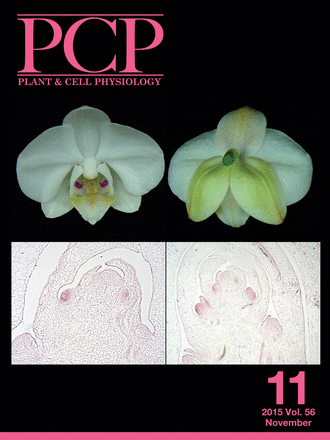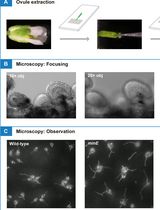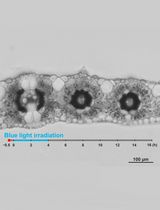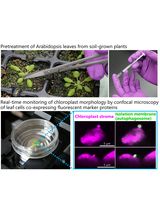- EN - English
- CN - 中文
Aniline Blue and Calcofluor White Staining of Callose and Cellulose in the Streptophyte Green Algae Zygnema and Klebsormidium
采用苯胺蓝和Calcofluor White对绿藻类双星藻属和克里藻属的胼胝质和纤维素进行染色
发布: 2016年10月20日第6卷第20期 DOI: 10.21769/BioProtoc.1969 浏览次数: 14658
评审: Maria SinetovaRumen IvanovAnonymous reviewer(s)
Abstract
Plant including green algal cells are surrounded by a cell wall, which is a diverse composite of complex polysaccharides and crucial for their function and survival. Here we describe two simple protocols to visualize callose (1→3-β-D-glucose) and cellulose (1→4-β-D-glucose) and related polysaccharides in the cell walls of streptophyte green algae. Untreated or algal cells heated in NaOH are incubated in Calcofluor white (binding to β-glucans including cellulose) or Aniline blue (binding to callose), respectively. Both dyes can be visualized by epifluorescence microscopy.
Background
Due to its easy and quick applicability, Aniline blue was used to visualize callose in various strains of Klebsormidium sp. and Zygnema sp., before more laborious fixation and immunolocalisation protocols were applied (Herburger and Holzinger, 2015). Applying Aniline blue staining and monoclonal antibodies against callose brought similar results (Herburger and Holzinger, 2015). Calcofluor white staining is the fastest way to visualize the 1→4-β-glucan fraction including cellulose of the cell wall, since no pre-treatments are required.
Materials and Reagents
- 2 ml Eppendorf tubes
- Epoxy coated microscopic slides with 8-12 wells (Thermo Fisher Scientific, Thermo ScientificTM, catalog number: 1014326410EPOXY ) and cover slips
- Algal cells or filaments (Figure 1A)
Note: In principle, this protocol is not restricted to green algae and can be applied to all plant cells surrounded by a cell wall, including cell cultures. - Sodium hydroxide pellets (NaOH) (EMD Millipore, catalog number: 106469 )
- A. bidest. (double distilled water)
- Sodium phosphate monobasic dihydrate (NaH2PO4·2H2O) (EMD Millipore, catalog number: 1063420250 )
- Sodium phosphate dibasic dihydrate (Na2HPO4·2H2O) (EMD Millipore, catalog number: 1065800500 )
- Culture medium (BBM [Bischoff and Bold, 1963], MBBM [Starr and Zeikus, 1993])
- Aniline blue diammonium salt (Sigma-Aldrich, catalog number: 415049 )
- Calcofluor white (Sigma-Aldrich, catalog number: 18909 )
Note: Adding Evans blue as a counterstain to diminish background fluorescence is not obligatory, since background fluorescence in the algae investigated is very low. - 0.2 M NaH2PO4·2H2O stock solution (see Recipes)
- 0.2 M Na2HPO4·2H2O stock solution (see Recipes)
- 50 ml of Sørensen’s phosphate buffer (see Recipes)
Equipment
- Glass Pasteur pipettes
- 25 ml beaker
- 1,000 ml and 500 ml volumetric flask
- 100 ml Schott flask
- Balance
- Pair of fine-pointed tweezers
- Metal rack (1.5 ml microfuge rack) (Thermo Fisher Scientific, Thermo ScientificTM, catalog number: 3166185 )
- Water bath or heat plate and beaker
- Tabletop centrifuge (Sigma Laborzentrifugen, model: Sigma 1-14 )
- Shaker (Thermo Fisher Scientific, Thermo ScientificTM, model: Compact Digital Microplate Shaker)
- Epifluorescence microscope capable of UV excitation and long pass detection, with high numerical aperture lens, connected to a camera for documentation (e.g., We used a ZEISS Axiovert 200M equipped with a 63 x 1.4 NA objective, a OSRAM HBO 50 Q/AC L1 CZ Mercury short ARC Photo optic lamp, Zeiss Filter Set 01 (excitation: band pass [BP] 365/12 nm; emission: long pass [LP] 397 nm and connected to a Axiocam MRc5 camera) (Carl Zeiss, model: Axiovert 200M )
Procedure
文章信息
版权信息
© 2016 The Authors; exclusive licensee Bio-protocol LLC.
如何引用
Herburger, K. and Holzinger, A. (2016). Aniline Blue and Calcofluor White Staining of Callose and Cellulose in the Streptophyte Green Algae Zygnema and Klebsormidium. Bio-protocol 6(20): e1969. DOI: 10.21769/BioProtoc.1969.
分类
植物科学 > 藻类学 > 细胞分析
植物科学 > 植物细胞生物学 > 细胞成像
细胞生物学 > 细胞成像 > 荧光
您对这篇实验方法有问题吗?
在此处发布您的问题,我们将邀请本文作者来回答。同时,我们会将您的问题发布到Bio-protocol Exchange,以便寻求社区成员的帮助。
Share
Bluesky
X
Copy link













